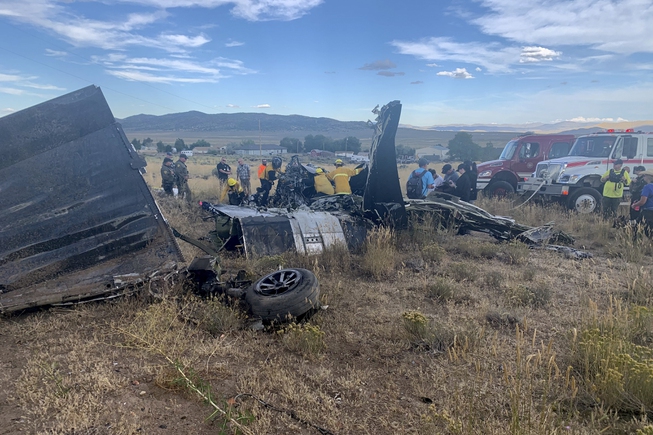
Adam R. Mayberry / Truckee Meadows Fire and Rescue via AP, file
Members of the Truckee Meadows Fire and Rescue Department of California and other officials look over aircraft wreckage, Sunday, Sept. 17, 2023, in Reno, after two California pilots were killed when their planes collided in mid-air while preparing to land after completing a race at the National Championship Air Races north of Reno.
Wednesday, Oct. 11, 2023 | 2:49 p.m.
RENO — A preliminary investigation suggests there was confusion among pilots just before a fatal mid-air collision at the National Championship Air Races last month but sheds little light on why.
The National Transportation Safety Board released a four-page report Wednesday with some of the few details investigators have pieced together in their preliminary probe of the cause of the Sept. 17 crash that killed veteran California pilots Chris Rushing of Thousands Oaks and Nick Macy of Tulelake.
Rushing had just won the T-6 title race and Macy had finished second when their vintage single-engine planes collided as they were moving into position about 300 feet (91 meters) off the ground to land at the Reno-Stead Airport, witnesses told the NTSB.
The third-place pilot, Vic McMann of Vancouver, British Columbia, said neither was where he thought they would normally be before he lost sight of them as they prepared to approach the runway along what's referred to as the “base leg” of the air traffic pattern, according to the NTSB report.
McMann said he continued to slow his airplane to “create some space and time to see them.” As he got closer to the runway he spotted Macy's plane and then “finally spotted” Rushing's plane below his position to the right. At that point, he could see Macy's plane in level flight, to his left. "Both airplanes were not where he expected them to be," the report said.
McMann said Rushing was on a “wider base” than the previous two flights, and Macy was “tighter” than his position, the report said.
He said Rushing “crossed in front of his position from right to left and disappeared" on the right side before Macy disappeared under his left wing.
“Shortly after, he observed Rushing where he expected him to be in level flight ... briefly before it began to roll to the right and descend," the report said.
Another witness stated that when the collision occurred Macy was at about a 75-degree angle headed downward in relation to Rushing's path, the report said.
A final report on the cause of the crash at the airport just north of Reno isn't expected to be completed for at least another year.
Rushing was the defending champion in the race he won that day. Macy, the runner-up, had won six times.
Aviation industry experts said in the days after the crash they were dumbfounded that such experienced pilots ended up colliding.
Reno Air Racing Association CEO Fred Telling, a former T-6 racer, was among those who noted the large wings on the planes used to train World War II pilots can restrict visibility for the pilot of a plane flying above another below.
“If you are in a turn, something immediately below you would be blanked out,” Telling said last month. “Or it could have been the glare of the sun.”
The collission brought an abrupt end to what was to be the celebrated finale of Reno’s run as the home of the national championships since 1964.
Event organizers were already looking for a new home for the competition after this year, partly because of rising insurance costs since 2011. That year a P-51D Mustang suffered a mechanical failure and crashed into the apron in front of the grandstand, killing the pilot and 10 spectators and seriously injuring 70 others. It was one of the deadliest air show disasters in U.S. history.
